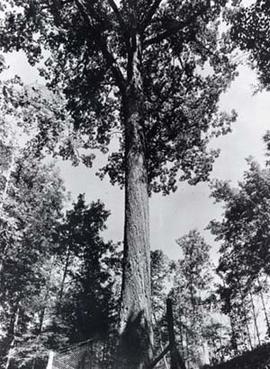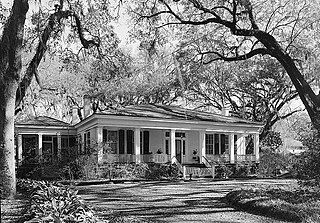
Mobile is a city and the county seat of Mobile County, Alabama, United States. The population was 187,041 at the 2020 census, and was estimated to be 183,289 in 2022.

Liriodendron is a genus of two species of characteristically large trees, deciduous over most of their populations, in the magnolia family (Magnoliaceae).

The Treaty Oak is a Texas live oak tree in Austin, Texas, United States, and the last surviving member of the Council Oaks, a grove of 14 trees that served as a sacred meeting place for Comanche and Tonkawa tribes before European colonization of the area. Foresters estimate the Treaty Oak to be about 500 years old. Before its vandalism in 1989, the tree's branches had a spread of 127 feet (39 m). The tree is located in Treaty Oak Park, on Baylor Street between 5th and 6th Streets, in Austin's West Line Historic District.

Quercus virginiana, also known as the southern live oak, is an evergreen oak tree endemic to the Southeastern United States. Though many other species are loosely called live oak, the southern live oak is particularly iconic of the Old South. Many very large and old specimens of live oak can be found today in the Deep South region of the United States.

The Wye Oak was the largest white oak tree in the United States and the State Tree of Maryland from 1941 until its demise in 2002. Wye Oak State Park preserves the site where the revered tree stood for more than 400 years in the town of Wye Mills, Talbot County, Maryland.

The Mingo Oak was a white oak in the U.S. state of West Virginia. First recognized for its age and size in 1931, the Mingo Oak was the oldest and largest living white oak tree in the world until its death in 1938.
Mohawk Trail State Forest is a publicly owned state forest in the U.S. state of Massachusetts with recreational features located in the towns of Charlemont, Hawley, and Savoy. It covers more than 7,700 acres (3,100 ha) of mountain ridges, gorges, and old-growth forests at elevations ranging from around 600 to 2,080 feet. It is managed by the Department of Conservation and Recreation.

Bottle Creek Indian Mounds (1BA2) is an archaeological site owned and monitored by the Alabama Historical Commission located on a low swampy island within the Mobile-Tensaw River Delta north of Mobile, Alabama, United States. It was occupied by the peoples of the Pensacola culture, a regional Mississippian culture variant, and is the largest site of the Mississippian culture on the central Gulf Coast. It is important to understanding the history and culture of the Mobile-Tensaw delta in late prehistoric times and was designated as a National Historic Landmark on March 10, 1995, making it one of only two such sites in Alabama.

Georgia Cottage, also known as the Augusta Evans Wilson House, is a historic residence in Mobile, Alabama, United States. It was added to the National Register of Historic Places on September 14, 1972, based on its association with Augusta Jane Evans. She was one of the most popular American novelists of the nineteenth century and the first female author in the United States to earn over $100,000 for her work, but has been largely forgotten in recent times.

The Big Oak is a large live oak located in Thomasville, Georgia, in the United States at the corner of Crawford Street and Monroe Street. The Big Oak is one of many historic landmarks located in Thomasville. The Big Oak was one of the earliest trees registered with the Live Oak Society. Registered by P.C. Andrews in 1936, the Big Oak was the forty-ninth live oak registered. At the time of registration, the Big Oak's girth was 21 feet 6 inches.

Friendship Oak is a 500-year-old southern live oak located on the Gulf Park campus of the University of Southern Mississippi in Long Beach, Mississippi. The campus was formerly Gulf Park College for Women from 1921 until 1971.
The Alabama Champion Tree Program is a listing of the largest known specimens of particular tree species, native or introduced, in the U.S. state of Alabama. It was established in 1970 by the Alabama Forestry Commission. The program was modeled on the National Register of Big Trees, started by the American Forests organization in 1940. The goal of Alabama's program is to record, heighten awareness of, and preserve the largest tree specimens in the state. It uses the same formula for recording tree specimens that was developed by American Forests. Former champions are removed from the list as new, larger, champions are identified and recorded. Although introduced species that have naturalized are generally eligible for the program, those species that the Alabama Invasive Plant Council considers to be invasive were removed from the listing in 2011 and are no longer eligible. With the addition of 20 new specimens in 2011, the program had a total of 159 Champion Trees listed.

The Boyington Oak is a historic Southern live oak in Mobile, Alabama. In a city with many live oaks that are famous for their age and size, the Boyington Oak stands out as a singular example of one famous for the folklore surrounding its origin.
Tree height is the vertical distance between the base of the tree and the tip of the highest branch on the tree, and is difficult to measure accurately. It is not the same as the length of the trunk. If a tree is leaning, the trunk length may be greater than the height of the tree. The base of the tree is where the projection of the pith (center) of the tree intersects the existing supporting surface upon which the tree is growing or where the seed sprouted. If the tree is growing on the side of a cliff, the base of the tree is at the point where the pith would intersect the cliff side. Roots extending down from that point would not add to the height of the tree. On a slope this base point is considered as halfway between the ground level at the upper and lower sides of the tree. Tree height can be measured in a number of ways with varying degrees of accuracy.
Trees have a wide variety of sizes and shapes and growth habits. Specimens may grow as individual trunks, multitrunk masses, coppices, clonal colonies, or even more exotic tree complexes. Most champion tree programs focus finding and measuring the largest single-trunk example of each species. There are three basic parameters commonly measured to characterize the size of a single trunk tree: tree height measurement, tree girth measurement, and tree crown measurement. Foresters also perform tree volume measurements. A detailed guideline to these basic measurements is provided in The Tree Measuring Guidelines of the Eastern Native Tree Society by Will Blozan.

The Webster Sycamore was an American sycamore in the U.S. state of West Virginia. Long recognized for its size, the Webster Sycamore was the largest living American sycamore tree in West Virginia until its felling in 2010. The tree stood approximately 4.5 miles (7.2 km) east of Webster Springs in Webster County, in a moist flood plain along the banks of the Back Fork Elk River, a tributary stream of the Elk River.

The Lover's Oak is a notably historic and large Southern live oak tree in Brunswick, Georgia. Located in the Brunswick Old Town Historic District, the tree is reportedly over 900 years old. The tree has a trunk diameter of 13 feet (4.0 m) and has 10 main limbs.
















